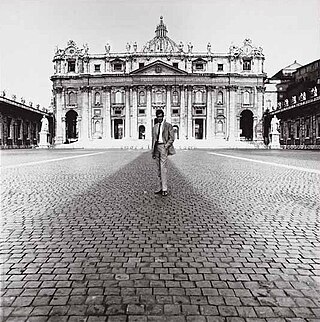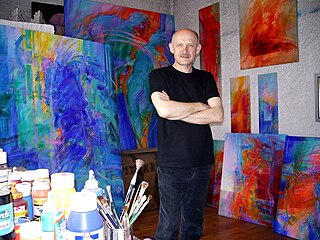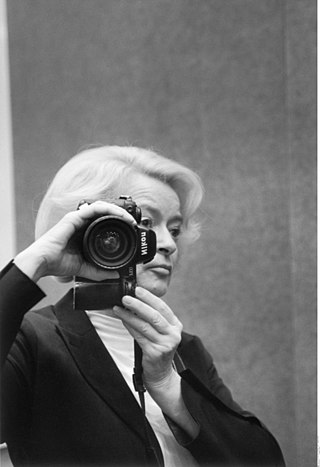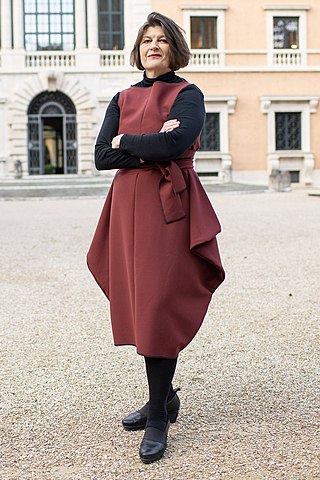
Maria Korporal (* June 1, 1962 in Sliedrecht, Netherlands) is a visual artist. Her artistic focus is on video art, interactive projects, installation, animation film, drawing and artist books.

Maria Korporal (* June 1, 1962 in Sliedrecht, Netherlands) is a visual artist. Her artistic focus is on video art, interactive projects, installation, animation film, drawing and artist books.
Maria Korporal was born Marianne Korporaal, in 2001 she changed her name to Maria Korporal. She studied graphic arts and painting at the St. Joost Academy of Fine Arts in Breda. [1] During her studies from 1981 to 1986, she began working with photography and film and graduated with a video installation. In 1986 she moved to Italy and founded the Italian publishing house Apeiron Editori [2] with Gerrit Van Oord in 1989, where she was responsible for the media design. [3] Until the end of 2013 she lived in Sant'Oreste, Rome, next to Monte Soratte. Then she moved to Berlin, where she lives and works as a freelance artist and web designer. [4]







Maria Korporal's artistic production includes video art, interactive projects, installations and drawings. [5] A project of more than 50 drawings and paintings dedicated to the music of Gustav Mahler, Das Lied von der Erde (1988/89) [6] [7] is one of the most important results of her early period in Italy. Activities at her publishing house, Apeiron Editori, stimulated Korporal's involvement with artists' books, of which Satori Soractis (1990) [8] and Contrapuncti (1991) [9] are representative and important for the 1990s.
Since 1998, the artist has been working mainly with new media. Her multimedia works are designed with a wide variety of techniques. The narrative aspect plays a major role in her work. Especially her interactive installations challenge the viewer to participate. Her works play with virtuality and reality, with undergone and artificially generated experiences. Most of her projects deal with social and environmental issues. [10] Particularly noteworthy are projects developed over several years. From 1998 to 2004 Maria Korporal created several installations consisting of computer-processed images, structured like a video wall with imitated screens. Contemporary imagery finds its way largely through screens (television, internet), which has an important impact on the way reality is seen and experienced, as the artist explains about The Rebellious Egg (2004) [11] and also about her cylindrical installation The Eye of the Golem (2000-2018). [12] Golem becomes a symbol of technology and a representative of modern thinking par excellence, able to adapt to different times and circumstances and see itself. Her project Korporal Zoo, [13] a series of video works between 2010 and 2018, observes the animal and human world from cultural, social, and environmental perspectives. Each work is an animated mix of footage in photo and film as well as drawings and collages, a standout example being Reynard the Fox. [14] Since 2021, the artist has returned to working with analog charcoal drawings, creating charcoal and pastel animations, such as S.A.D. (2021) [15] and The Wishing Table (2023). [16] The Breathearth Project (2016-2022) [17] and Emergency Call (2019-2022) [18] are interactive video installations that address the Earth and its changes, natural vegetation disappearing, climatological extremes occurring worldwide. [19] Korporal also develops a form of 360° video and works with virtual reality, as well as augmented reality. In her works such as Pervitin Power (2021), [20] Qorporal Qodes (2022) [21] and Qat Qube (2023), [22] she uses a combination of analog and digital techniques to explore certain themes in depth.
Maria Korporal is an active member of the Verein Berliner Künstler (Association of Berlin Artists) and the project space Group Global 3000 - Art and Other Sustainabilities in Berlin. Her videos are represented in Italy by VisualContainer, [23] Milan.
Her works have been shown and awarded internationally in numerous exhibitions. Festivals where her videos have been presented are: Cyland - International Media Art Festival, [24] Digital Media Fest, FIVAC, Video Art Miden, [25] Fest Anča, [26] FONLAD, Food Film Fest, Madatac, [27] Now & After, Unabhängiges Medienfestival Tübingen, WRO Media Art Biennale, InVideo, [28] Bolzano Short Film Festival, Inheritance Festival, Instants Vidéo, [29] Proyector, Magmart, [30] MashRome FilmFest, Mediawave Festival, Strangloscope, [31] Cyberfest, [32] ReggioFilmFestival, The Short Nights of Berlin, Over the Real, [33] Ibrida, [34] Vertical Movie Festival, Videomedeja, [35] Vierte Welle Festival. [36]

Elaine Frances Sturtevant, also known professionally as Sturtevant, was an American artist. She achieved recognition for her carefully inexact repetitions of other artists' works.

Lothar Wolleh was a well-known German photographer.

Jeffrey Isaac is a painter and video artist. His style often uses photorealism as a means to a conceptual inquiry of fantastical content with an absurdist approach.

Antoni Karwowski is a Polish lyrical abstraction and neofiguration painter and a performance artist.
Susanne Kessler is a German – Italian painter, illustrator and installation artist.

Simon Berger, born in 1976, is a Swiss contemporary visual artist. He is best known for pioneering the art made by breaking glass with a hammer. His work has been widely exhibited around the world.
Frieda Gertrud Riess was a German portrait photographer in the 1920s with a studio in central Berlin.

Alfredo Aceto is a visual artist based between Turin and Geneva. Aceto was born in Turin, Italy. He studied fine arts at the École cantonale d'art de Lausanne (ÉCAL). His work has been exhibited in many international surveys, including DOC!, Paris, Museo Pietro Canonica, Rome, Museo del 900, Milan, Centre d’Art Contemporain de Genève, Geneva, and Kunsthaus Glarus, Glarus. His practice includes film, installation, performance, text and sculpture, and is mainly concerned with the body and the biography.

Asta Gröting is a contemporary artist. She works in a variety of media like sculpture, performance, and video. In her work, Gröting “is conceptually and emotionally asking questions of the social body by taking something away from it and allowing this absence to do the talking.”
Pola Sieverding is a German photographer and video artist. She works in the field of lens based media.
Luise Begas-Parmentier (1843–1920) was an Austrian-German landscape and architecture painter and Salonière.

Sandra Becker is a Berlin-based video artist.

Angelika Platen is a German photographer known internationally for her portraits of artists.
Ali Kaaf is a Syrian-born German visual artist. His artistic style focuses on pictorial language, and works to connect the worlds of Beirut, Berlin, and the United States.

Lorenz Kienzle is a German photographer. He has been living in Berlin since 1991.

Julia Draganović is a German curator and cultural manager. German-Italian cultural relations have been a recurring theme in her work. In July 2019 she became director of the German Academy in Rome Villa Massimo.
Laura J. Padgett is an American artist, working mainly in photography and film.

Mathilde Block was a German painter and embroiderer. Her artworks and paintings range from pencil portraits to embroidered quilts and have been exhibited in numerous art expositions throughout the world.
Ottilie Reylaender was a German painter. She was one of the pioneers of modern art in Germany.

Pomona Zipser is a Romanian-born contemporary artist based in Berlin, known for her sculptures. She was born in 1958 in Romania and moved to Germany with her mother in 1970. Zipser studied at the Academy of Fine Arts in Munich and the Berlin University of the Arts.